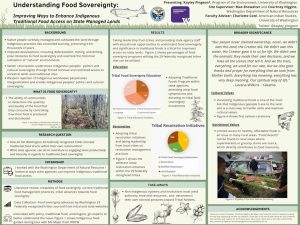UNDERSTANDING FOOD SOVERIGNTY AND IMPROVING WAYS TO ENHANCE INDIGENOUS TRADITIONAL FOOD ACCESS ON STATE MANAGED LANDS
State owned land in the United States is intended to be used by the public for trust beneficiaries like school education, as well as for recreational activities. This has come at the expense of many Indigenous peoples whose traditional harvesting and hunting grounds reside on these lands. State lands are open to tribal members, communities often experience barriers to accessing traditional hunting or harvesting areas. Often capitalistic, colonialist structures have aided in lack of resources needed to provide access. The aim of this study is to identify ways in which state agencies can increase Indigenous traditional food access. During my time with the Washington Department of Natural Resources I evaluated factors leading to inequities of current land use for Washington‚ 29-federally recognized tribes, how the 29-federally recognized tribes are increasing traditional foods access, and how state agencies can contribute to engaging more productively and honestly when engaging in traditional foods and food sovereignty. To accomplish this scholarly literature review, anecdotal evidence gathered, and interviews to better understand the DNR‚ and the 29-Federally recognized tribes, relations with traditional foods. With this information, I found it vitally important that agencies managing state lands have educated staff on food sovereignty as well as, actively and systematically engage with tribal communities, in a government-to-government fashion, to further evaluate and better traditional food activities, access, and availability. If active engagement and education across state agencies is made priority Indigenous traditional food access will be improved on state lands.
